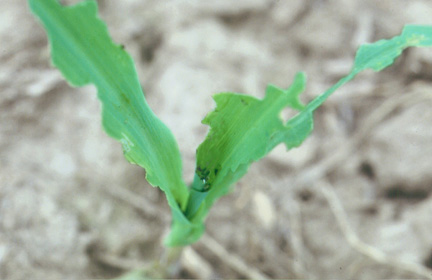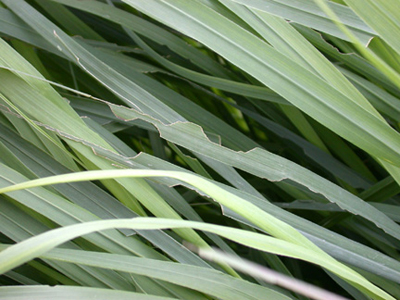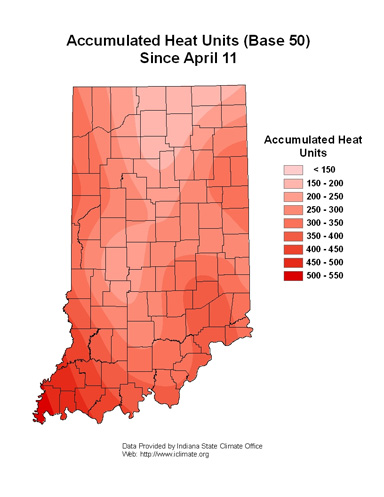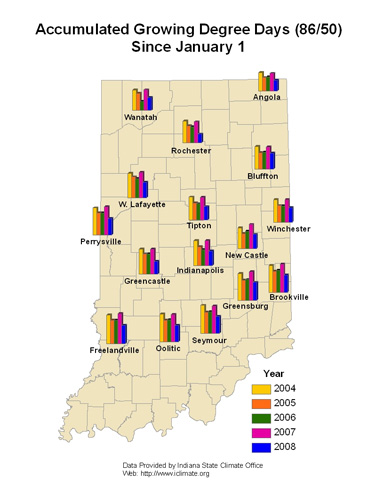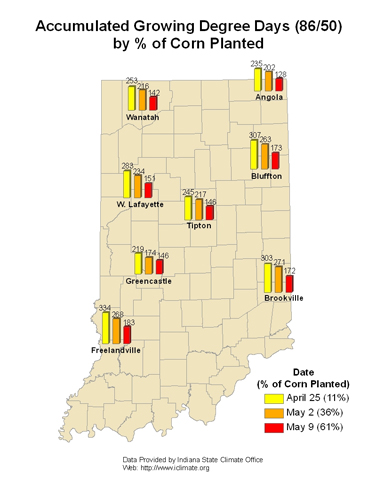Pest & Crop Newsletter, Entomology Extension, Purdue University
- Armyworm, Don't Get Unpleasantly Surprised
- Don't Forget About Alfalfa Insect Pests!
- Accumulated Heat Units (Base 50)
Armyworm, Don’t Get Unpleasantly Surprised – (John Obermeyer and Larry Bledsoe)
- Moths lay eggs on grassy crops and weeds.
- Corn can be quickly consumed when grass cover crop is burned down.
- Wheat defoliation and head clipping can result.
- Fescue pastures can be denuded in days.
As previously reported, Kentucky has captured impressive moth numbers in their pheromone traps and now are seeing infestation take hold. Moths prefer to lay their eggs on dense grassy vegetation (e.g., wheat, grass hay, and grass cover crops). Initially, tiny larvae and their damage are hard to find. Larval development, especially in southern counties, should now have advanced to the point that high-risk crops should be assessed for feeding damage. To date, no reports of economic damage have been received in Indiana; indicating infestations may be typically spotty rather than widespread as in 2001.
Corn - Corn that has been no-tilled into or growing adjacent to a grass cover crop (especially rye) should be inspected immediately for armyworm feeding. Hatched larvae will move from the dying grasses to emerging/emerged corn. Armyworm feeding gives corn a ragged appearance, with feeding extending from the leaf margin toward the midrib. Damage may be so extensive that most of the plant, with the exception of the midrib and stalk, is consumed. A highly damaged plant may recover if the growing point has not been destroyed. If more than 50% of the plants show armyworm feeding and live larvae less than 1-1/4 inches long are numerous in the field, a control may be necessary. Larvae greater than 1-1/4 inches consume a large amount of leaf tissue and are more difficult to control. If armyworm are detected migrating from border areas or waterways within fields, spot treatments in these areas are possible if the problem is identified early enough. Don’t rely on Bt-corn for protection, as all are vulnerable to damage.
Armyworm feeding on 4-leaf corn
Wheat & Grass Pasture - Examine plants in different areas of a field, especially where plant growth is dense. Look for flag leaf feeding, clipped heads, and armyworm droppings on the ground. Shake the plants and count the number of armyworm larvae on the ground and under plant debris. On sunny days, the armyworm will take shelter under crop residue or soil clods. If counts average approximately 5 or more per linear foot of row, the worms are less than 1-1/4 inches long, and leaf feeding is evident, control may be justified. If a significant number of these larvae are present and they are destroying the leaves or the heads, treat immediately.
Armyworm feeding on forage grass
| Armyworm Insecticides (Read and follow ALL label rate, application, and use directions) | ||
| Crop | Product (Formulation | Restrictions (Days to Harvest) |
| Corn | Ambush (EC) Asana XL Baythroid CL Cobalt Hero Lannate (SP) Lorsban (4E) Mustang Max (EC) Penncap-M Pounce (EC) Sevin (4F, 80S, XLR) |
30 21 21 21 30 21 35 30 12 30 48 |
| Wheat | Baythroid XL Lannate (SP) Malathion (EC) Mustang Max (EC) Penncap-M Sevin (4F, 80S, XLR) Warrior |
30 7 (10 for grazing/feeding) 7 14 15 (harvest or grazing) 21 grain harvest, 7 grazing forage 30 |
| Grass Pasture | Malathion (EC) Mustang Max (EC) Sevin (4F, 80S, XLR) |
0 0 (forage and hay) 14 (harvest or grazing) |
![]()
Don’t Forget About Alfalfa Insect Pests! - (Larry Bledsoe and John Obermeyer)
- Weevil continue to feed after cutting.
- Potato leafhopper has joined alfalfa weevil in alfalfa.
- Increased crop value increases urgency of management.
Normally, alfalfa weevil diminishes in importance at this time of year and we begin discussing the potato leafhopper in its place. This season is different in that the weather conditions have brought these two pests together making management of this high valued crop a little more urgent.
The generally cool and damp weather during the spring and early summer has certainly slowed planting and other farm activities, but not the activity of some alfalfa pests! Alfalfa weevil is adapted to cool weather. Its activity and crop injury are normally greatest in early spring and late fall. The arrival of warm days in early May usually mark the beginning of the end of weevil season as natural controlling agents reduce the number of weevils and the life cycle of the weevil shifts to the summer resting stage. This year, the continued cool nights and cool cloudy days have resulted in extended activity of the weevils. Some producers in southern counties have managed the weevil by taking the first cutting early. Northern producers need to assess stands to determine if early cutting or chemical applications are appropriate. It is important that producers scout new growth after cutting for new weevil injury to emerging foliage.
The potato leafhopper (PLH) is a pest that is typically carried into our state on southerly winds and storms. Although severe storm activity has been slight this season, this pest has now made its way to Indiana. PLH is normally a pest of second cutting hay, but slow development of forages this year has this pest present in first cutting hay, at least in northern counties. Now is the time to choose a dry day to sweep the standing crop. See the management guide below to determine if you need to take action. Cutting the first growth crop is a good management tool if the alfalfa is near bud stage. As with weevil, it is important to monitor the regrowth for the presence of hoppers. Remember that this is a pest in which the producer must be proactive. Management is triggered by the abundance of PLH relative to the average length if the alfalfa stems. Once the results of feeding injury is seen (V-shaped, yellow leaf tips, aka ‘hopper burn’), much of the injury has already occurred.
| Management Thresholds for Potato Leafhoppers | |
(Adults/Nymphs) Leafhoppers Per Sweep |
Alfalfa Stem Height in Inches |
under 3 |
0.2 |
4 - 6 |
0.5 |
7 - 12 |
1.0 |
greater than 12 |
1.5 |
Whether you are managing alfalfa weevils, potato leafhopper or both at the same time, if you choose to apply insecticides, remember that best results from insecticides are obtained when treatment occurs while foliage is small. For recommended insecticides see Extension Publication E-220, Alfalfa Insect Control Recommendations - 2008 which canbe viewed at <http://extension.entm.purdue.edu/publications/E-220.pdf>.
![]()
More Thoughts on Late Corn Planting - (Bob Nielsen)
Completion of the 2008 corn planting season throughout Indiana remains a distant light at the end of a wet tunnel. Planting progress as of 18 May was reported to be 68% complete statewide, but only 37% complete throughout southern Indiana (USDA-NASS, 19 May). Reports are coming in that some of the earlier planted corn is being replanted or may require so in the near future because of unacceptable stand establishment due to damage from soggy soils, soil-borne insect damage, or seedling blight damage. Obviously, the calendar continues to move on or, in the memorable words of John Wayne, “we’re burnin’ daylight.”
Slow drying soils due to cool weather plus additional rainfall that spread throughout much of the state on Friday probably translate to little significant planting progress since the 18 May estimate. While we know from experience that much of the remaining corn acres could be planted in a week’s worth of good working days, the upshot is that quite a few acres will either be planted very late or those acres will be switched over to soybeans.
Yield Potential of Late-Planted Corn
Ah, yes.......the $6 per bushel question is how much yield loss should I expect if I continue to plant corn through the early weeks of June? One of the most cited references for that answer is the dataset from the Univ of Illinois that we reproduce in Purdue’s ID-179 (Corn and Soybean Guide) and is provided below. Based on that dataset, we can speculate that corn yield potential decreases significantly with late May and early June plantings. As I’ve indicated before though (Nielsen, 2008a), these estimates are relative to the yield potential of a given year. If the remainder of this growing season turns out to be fantastic for corn, the percent yields listed in the table may yet result in acceptable actual bushel yields. If, however, the remainder of this growing season continues to be a sorry mess for corn, then the percent yield losses listed in the table will translate to even sorrier actual bushel yields this fall.
Hybrid Maturity for Late-Planted Corn
Growers who intend on “sticking to their guns” with corn acres should be talking with their seed dealers now about possible switches to earlier maturity hybrids, especially those who farm in northern or eastcentral Indiana. The accompanying table lists relative hybrid maturities that could safely be planted over the next three weeks based on expected heat unit needs and a “normal” accumulation of heat units from planting to a killing fall frost date. See my earlier article (Nielsen, 2008b) for more detail on how these hybrid maturity recommendations are developed.
The good news, if there is any, is that growers in southern Indiana could continue planting adapted full-season hybrids through the middle of June with little if any risk of the crop not maturing prior to a killing fall frost. Today’s reality is that “full-season” hybrids for many southern Indiana growers are earlier maturity than those listed in the accompanying table. Plant breeders have made such improvements in the yield potential of 110 - 115 day hybrids over the past decade that many growers take advantage of their excellent yield potential and drier grain versus later maturity hybrids.
Tip: Growers who elect to switch to earlier maturity hybrids should consider using hybrids with the Bt-corn borer trait, especially in southern Indiana. European and southwestern corn borers are especially attracted to late-planted corn. See John Obermeyer’s recent newsletter article (Obermeyer, 2008).
Another Tip: Growers who elect to switch to earlier maturity hybrids should pay close attention to choosing hybrids with excellent disease resistance and general late-season plant health or standability characteristics.
| Approx. "safe" relative maturities for late planting dates in Indiana with assumption that the hybrid will mature the week of expected fall frost date. | |||||
Crop Rpt District |
"Typical" CRM |
Expected Fall Frost Date |
Planting Date... |
||
31-May |
7-June |
14-June |
|||
Approx. "safe" relative maturity |
|||||
NW |
109 |
6-Oct |
108 |
106 |
102 |
NC |
109 |
6-Oct |
108 |
105 |
102 |
NE |
109 |
6-Oct |
106 |
103 |
100 |
WC |
112 |
13-Oct |
118 |
115 |
112 |
C |
112 |
13-Oct |
116 |
113 |
109 |
EC |
109 |
6-Oct |
108 |
106 |
102 |
SW |
116 |
20-Oct |
118+ |
118+ |
118+ |
SC |
113 |
13-Oct |
118+ |
118+ |
116 |
SE |
113 |
13-Oct |
118+ |
118+ |
117 |
50 PCT Fall Frost Risk Date |
|||||
Seeding Rates for Late-Planted Corn
The only consideration for seeding rate decisions and late planted corn is that growers may want to reduce their seeding rate just a tad. Optimal final stands for late-planted corn are similar to those for earlier-planted corn (see above planting date/population table), BUT recommended seeding rates for earlier-planted corn are calculated assuming that 5 to 10% of the seed either will not germinate or subsequent seedlings will die due to typical wet, cold, and otherwise crappy early season conditions. One of the few positive aspects of late-planted corn is that stand establishment should be more successful due to warmer soils and more rapid germination/emergence conditions. So, instead of bumping seeding rates by roughly 10% as we suggest for earlier-planted corn, growers could back off to seeding rates that are equal to or 5% above their target final populations.
Seeding Depth for Late-Planted Corn
The key factor for selecting seeding depth for late-planted corn is uniformity of seedbed moisture for germination. One of the risks of later planted corn is that the seed zone can dry out much more quickly than it usually does with earlier-planted corn. Check the seedbed moisture conditions the day you plant and give some credence to the 6 to 10 day rainfall forecast. Aim for a seeding depth that will best ensure uniform soil moisture, but do not plant any shallower than 1.5 inches.
Starter Fertilizer for Late-Planted Corn
Whether or not starter fertilizer will “pay off” with late planting is often not easy to predict. However, given that the benefits of starter fertilizer are most evident when the first 30 to 45 days after planting are wet, cold, and otherwise crappy, one could argue that there may not be much reason to use starter fertilizer for late-planted corn. The high cost of many starter fertilizer sources this year may also influence this decision.
Related References
Lee, Chad. 2008. Late Corn Planting Dates and Potential Yields. Univ. of Kentucky. [On-line]. Available at <http://www.uky.edu/Ag/GrainCrops/Briefs/Corn_LatePlanting2008.htm>. [URL accessed 5/23/08].
Nielsen, R.L. (Bob). 2008a. Corn Planting Date is Important, But.... Corny News Network, Purdue Extension. [On-line]. Available at URL: <http://www.kingcorn.org/news/articles.08/PltDate-0412.html>. [URL accessed 5/23/08].
Nielsen, R.L. (Bob). 2008b. Late Planting/Replanting & Relative Hybrid Maturity. Corny News Network, Purdue Extension. [On-line]. Available at URL: <http://www.kingcorn.org/news/articles.08/DelayedPlt_Hybrids.html>. [URL accessed 5/23/08].
Obermeyer, John. 2008. Consider Corn Borer-Bt for Late-Planted Corn in Southern Indiana Pest & Crop Newsletter (16 May), Purdue Extension. [On-line]. Available at <http://extension.entm.purdue.edu/pestcrop/
2008/issue7/index.html>. [URL accessed 5/23/08].
Thomison, Peter. 2008. Should Seeding Rates be Changed for Delayed Corn Plantings?. C.O.R.N. Newsletter (20 May), Ohio State Extension. [On-line]. Available at <http://corn.osu.edu/index.php?setissueID=229>. [URL accessed 5/23/08].
USDA-NASS. 2008. Indiana Crop & Weather Report (19 May 2008). Indiana office of USDA’s National Ag. Statistics Service. [On-line]. Available at <http://www.nass.usda.gov/Statistics_by_State/Indiana/
Publications/Crop_Progress_&_Condition/2008/wc051908.pdf>. [URL accessed 5/23/08].

